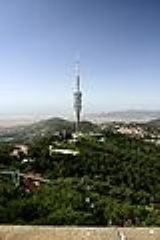
Torre de Collserola
Encyclopedia
Torre de Collserola (ˈtorə ðə kuʎsəˈɾɔɫə) is a uniquely designed tower located on the Tibidabo
hill in the Serra de Collserola
, in Barcelona
, Catalonia
, Spain
. It was designed by architect Sir Norman Foster
, and built in 1991 for the 1992 Summer Olympics
. It features a pod for floor space like many towers but uses guy wires for lateral support like a mast. Mainly used as a TV and radio transmitter, this futuristic design provides the highest viewpoint over the city. The top antenna reaches 288.4m (946 ft) and the top of the pod, which has thirteen floors, reaches 152m (499 ft).
The tenth floor of the pod is open to the public.
The thirteen floors are surrounded by a perimeter of open stainless steel grilles and suspended from the shaft by three primary vertical steel trusses.
The total weight of the tower is 3,000 tons.
A large number of cables keep the tower upright:
Tibidabo
Tibidabo is a mountain overlooking Barcelona, Catalonia, Spain. At 512 meters it is the tallest mountain in the Serra de Collserola. Rising sharply to the north-west, it affords spectacular views over the city and the surrounding coastline....
hill in the Serra de Collserola
Serra de Collserola
The Serra de Collserola , or simply Collserola, is a mountain range between the rivers Besòs and Llobregat. It is part of the Catalan Coastal Range....
, in Barcelona
Barcelona
Barcelona is the second largest city in Spain after Madrid, and the capital of Catalonia, with a population of 1,621,537 within its administrative limits on a land area of...
, Catalonia
Catalonia
Catalonia is an autonomous community in northeastern Spain, with the official status of a "nationality" of Spain. Catalonia comprises four provinces: Barcelona, Girona, Lleida, and Tarragona. Its capital and largest city is Barcelona. Catalonia covers an area of 32,114 km² and has an...
, Spain
Spain
Spain , officially the Kingdom of Spain languages]] under the European Charter for Regional or Minority Languages. In each of these, Spain's official name is as follows:;;;;;;), is a country and member state of the European Union located in southwestern Europe on the Iberian Peninsula...
. It was designed by architect Sir Norman Foster
Norman Foster, Baron Foster of Thames Bank
Norman Robert Foster, Baron Foster of Thames Bank, OM is a British architect whose company maintains an international design practice, Foster + Partners....
, and built in 1991 for the 1992 Summer Olympics
1992 Summer Olympics
The 1992 Summer Olympic Games, officially known as the Games of the XXV Olympiad, were an international multi-sport event celebrated in Barcelona, Catalonia, Spain, in 1992. The International Olympic Committee voted in 1986 to separate the Summer and Winter Games, which had been held in the same...
. It features a pod for floor space like many towers but uses guy wires for lateral support like a mast. Mainly used as a TV and radio transmitter, this futuristic design provides the highest viewpoint over the city. The top antenna reaches 288.4m (946 ft) and the top of the pod, which has thirteen floors, reaches 152m (499 ft).
The tenth floor of the pod is open to the public.
Construction
The tower has a hollow slip-formed, reinforced concrete main shaft of only 4.5 m diameter, which reduces to a mere 3 m to hold a radio mast which telescopes from 2.7 m to 0,7m.The thirteen floors are surrounded by a perimeter of open stainless steel grilles and suspended from the shaft by three primary vertical steel trusses.
The total weight of the tower is 3,000 tons.
A large number of cables keep the tower upright:
- The lower guys are composed three series of 180 parallel strand cables (15 mm diameter) made from pre-tensioned high-strength steel with a polyethylene covering, each;
- The upper guys are made of three series of 7 aramidTwaronTwaron is the brandname of Teijin Aramid for a para-aramid. It is a heat-resistant and strong synthetic fibre developed in the early 1970s by the Dutch company AKZO, division Enka, later Akzo Industrial Fibers. The research name of the para-aramid fibre was originally Fiber X, but it was soon...
fibre cables in parallel (56 mm diameter), each terminated with a resin socket. The three upper cables have a combined breaking strength of 4,200 tons.

